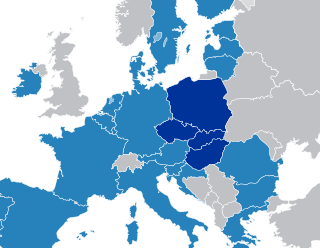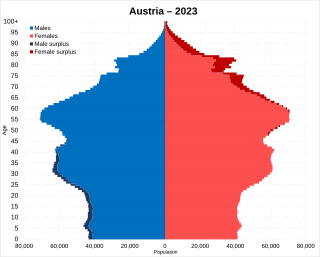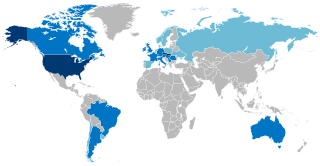
Central Europe is a geographical region of Europe between Eastern, Southern, Western and Northern Europe. Central Europe is known for its cultural diversity; however, countries in this region also share certain historical and cultural similarities.

The Czech Republic, also known as Czechia, is a landlocked country in Central Europe. Historically known as Bohemia, it is bordered by Austria to the south, Germany to the west, Poland to the northeast, and Slovakia to the southeast. The Czech Republic has a hilly landscape that covers an area of 78,871 square kilometers (30,452 sq mi) with a mostly temperate continental and oceanic climate. The capital and largest city is Prague; other major cities and urban areas include Brno, Ostrava, Plzeň and Liberec.

Slovakia, officially the Slovak Republic, is a landlocked country in Central Europe. It is bordered by Poland to the north, Ukraine to the east, Hungary to the south, Austria to the west, and the Czech Republic to the northwest. Slovakia's mostly mountainous territory spans about 49,000 square kilometres (19,000 sq mi), hosting a population exceeding 5.4 million. Bratislava serves as the capital and largest city, while the second largest city is Košice.

The Visegrád Group is a cultural and political alliance of four Central European countries: the Czech Republic, Hungary, Poland, and Slovakia. The alliance aims to advance co-operation in military, economic, cultural and energy affairs, and to further their integration with the EU. All four states are also members of the European Union (EU), the North Atlantic Treaty Organization (NATO), and the Bucharest Nine (B9).

Vienna is the capital, largest city, and one of nine federal states of Austria. Vienna is Austria's most populous city and its primate city, with about two million inhabitants, and its cultural, economic, and political center. It is the sixth-largest city proper by population in the European Union and the largest of all cities on the Danube river by population.

Demographic features of the population of Austria include population density, ethnicity, education level, health of the populace, economic status, religious affiliations and other aspects of the population.

The German diaspora consists of German people and their descendants who live outside of Germany. The term is used in particular to refer to the aspects of migration of German speakers from Central Europe to different countries around the world. This definition describes the "German" term as a sociolinguistic group as opposed to the national one since the emigrant groups came from different regions with diverse cultural practices and different varieties of German. For instance, the Alsatians and Hessians were often simply called "Germans" once they set foot in their new homelands.

Burgenland is the easternmost and least populous state of Austria. It consists of two statutory cities and seven rural districts, with a total of 171 municipalities. It is 166 km (103 mi) long from north to south but much narrower from west to east. The region is part of the Centrope Project. The name of Burgenland was invented/coined in 1922, after its territories became part of Austria.

Austrians are the citizens and nationals of Austria. The English term Austrians was applied to the population of Habsburg Austria from the 17th or 18th century. Subsequently, during the 19th century, it referred to the citizens of the Empire of Austria (1804–1867), and from 1867 until 1918 to the citizens of Cisleithania. In the closest sense, the term Austria originally referred to the historical March of Austria, corresponding roughly to the Vienna Basin in what is today Lower Austria.

The Slovaks are a West Slavic ethnic group and nation native to Slovakia who share a common ancestry, culture, history and speak the Slovak language.

Trnava is a city in western Slovakia, 47 km (29 mi) to the northeast of Bratislava, on the Trnávka river. It is the capital of the Trnava Region and the Trnava District. It is the seat of a Roman Catholic archbishopric. The city has a historic center. Because of the many churches within its city walls, Trnava has often been called "Little Rome", or more recently, the "Slovak Rome".

Břeclav is a town in the South Moravian Region of the Czech Republic. It has about 25,000 inhabitants.

Michalovce is a town on the Laborec river in eastern Slovakia. Originally named after the Archangel St Michael, it is the second-largest city in the Košice Region and the seat of the Michalovce District.

The United States of Greater Austria was an unrealized proposal made in 1906 to federalize Austria-Hungary to help resolve widespread ethnic and nationalist tensions. It was conceived by a group of scholars surrounding Archduke Franz Ferdinand of Austria, notably by the ethnic Romanian lawyer and politician Aurel Popovici.

There are an estimated 20,000 Muslims in the Czech Republic, representing 0.2% of the country's population. The growing Turkish community form the largest Muslim population in the country.
Czech Americans, known in the 19th and early 20th century as Bohemian Americans, are citizens of the United States whose ancestry is wholly or partly originate from the Czech lands, a term which refers to the majority of the traditional lands of the Bohemian Crown, namely Bohemia, Moravia and Czech Silesia. These lands over time have been governed by a variety of states, including the Kingdom of Bohemia, the Austrian Empire, Czechoslovakia, and the Czech Republic also known by its short-form name, Czechia. Germans from the Czech lands who emigrated to the United States are usually identified as German Americans, or, more specifically, as Americans of German Bohemian descent. According to the 2000 U.S. census, there are 1,262,527 Americans of full or partial Czech descent, in addition to 441,403 persons who list their ancestry as Czechoslovak. Historical information about Czechs in America is available thanks to people such as Mila Rechcigl.

The history of the Jews in the Czech lands, historically the Lands of the Bohemian Crown, including the modern Czech Republic, goes back many centuries. There is evidence that Jews have lived in Moravia and Bohemia since as early as the 10th century. Jewish communities flourished here specifically in the 16th and 17th centuries, and again in the late 19th and early 20th centuries. Local Jews were mostly murdered in the Holocaust, or exiled at various points. As of 2021, there were only about 2,300 Jews estimated to be living in the Czech Republic.

Bratislava, historically known as Preßburg (Pressburg) German pronunciation:[ˈpʁɛsˌbʊʁk], is the capital and largest city of Slovakia. Officially, the population of the city is about 475,000; however, it is estimated to be more than 660,000—approximately 140% of the official figures. Bratislava is in southwestern Slovakia at the foot of the Little Carpathians, occupying both banks of the River Danube and the left bank of the River Morava. Bordering Austria and Hungary, it is the only national capital to border two sovereign states.

Austria, formally the Republic of Austria, is a landlocked country in Central Europe, lying in the Eastern Alps. It is a federation of nine federal states, one of which is the capital, Vienna, the most populous city and federal state. Austria is bordered by Germany to the northwest, Czech Republic to the north, Slovakia to the northeast, Hungary to the east, Slovenia and Italy to the south, and Switzerland and Liechtenstein to the west. The country occupies an area of 83,900 km2 (32,394 sq mi) and has a population of around 9 million.
Slovaks in Austria have a history dating back to the early centuries of the Common Era. Currently, there are 35,326 Slovaks in Austria as of 2016. Large communities of Slovaks can be found in Vienna and Lower Austria, with a smaller community in Styria.

















